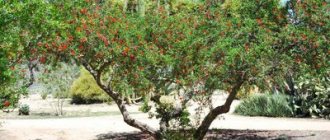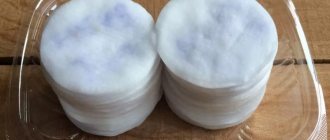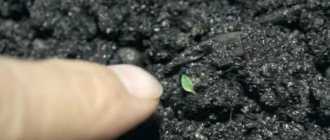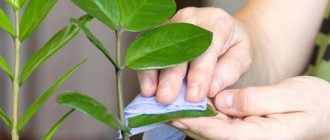Every year, cultivating citrus fruits indoors is becoming an increasingly popular hobby among gardeners. Most often, window sills are decorated with lemons; you can also often see tangerines. However, there are also more exotic representatives of Citrus fruits, for example, calamondin, which is also called citrofortunella.
Calamondin is a hybrid that is the result of crossing a kumquat and a mandarin orange. This plant is excellent for growing indoors, and it gives a good harvest.
Features of calamondin
Under natural conditions, calamondin is grown in Southeast Asia. In nature, the height of a tree can reach about 700 cm. Trees grown indoors have more modest sizes. The maximum height of indoor citrofortunella is 120 centimeters.
The branches are decorated with oval leaf plates with a glossy surface. Flowering is observed in spring and summer. At this time, small white star-shaped flowers are formed on the tree, which have a pleasant aroma.
If you care for such a citrus plant correctly and provide it with favorable conditions for growth, then the formation of fruits will be observed all year round. Externally, calamondin fruits are similar to tangerines, but they are smaller in size: on average they weigh from 10 to 15 grams. They also have a special bitter-sour taste.
Calamondin. The fruits are ripe
About the flowering of the tangerine tree
When the plant begins to bloom, you cannot move it from place to place so that the flowers do not fall off.
Also, during the period of active flowering, it is important to feed the tree with citrus fertilizer.
To see the fruits for which the tangerine tree is actually grown, you will have to work as a pollinator bee. We touch each white star with a brush and transfer the pollen to another flower. The fruits ripen for a long time, from 3 to 5 months, and grow very small, smaller than the tangerine we are familiar with.
What to do after purchase?
If you purchase grown citrofortunella in a specialized store, then you need to remember that it is grown using a special technology for sale. As a rule, when placed in indoor conditions, a tree needs some time to adapt. In addition, plants that already bear fruit are often put up for sale.
In order for the citrus to grow and develop further after fruiting, it must be provided with optimal conditions so that it can successfully get used to the new place. If you neglect this advice, the bush may die.
Creating comfortable conditions:
- you need to create a mini-greenhouse for the plant: to do this, cover it on top with a plastic bag;
- systematic ventilation is required (twice a day);
- watering should be such that the substrate in the pot does not dry out;
- for the bush you should choose a place protected from direct sunlight;
- When purchasing a tree in winter, it is provided with additional lighting.
It is very simple to understand that the plant has fully adapted to new conditions. New foliage will begin to form on the bush. As a rule, the adaptation period for citrus takes about 15 days.
Adaptation of citrus fruits after receipt
Where should Citrofortunella be located?
The homeland of the tangerine tree is the land of the rising sun. This means that at home it will grow in a well-lit room. Which side is better to put it on? It all depends on the time of day and year. For example, in the morning and at sunset you can leave it in direct sunlight, but since the midday sun is destructive, it is better to move the pot to a shaded place during the day.
Of course, it’s unlikely that anyone will rush around with a potty every day, so I advise you to close the window from ultraviolet rays with curtains or blinds.
Also, during the hot period, citrofortunella will feel great on the western or eastern side. In winter, it stops growing, its metabolism slows down, and you can safely move the plant to the north side.
Caring for calamondin at home
In order for calamondin to bloom regularly and bear fruit at home, you should adhere to the temperature regime recommended by a specialist, as well as provide it with proper lighting and regular moderate moisture of the soil mixture in the pot.
Choosing a pot
This citrus is a spectacular tree with a developed root system. This should definitely be taken into account when choosing a container for planting it. The earthen ball of the tree should be one and a half times smaller than the diameter of the selected pot. For the normal development of such a plant, it needs space.
Lighting
For indoor calamondin, it is better to choose a window sill with an eastern or southern orientation. In this case, it is necessary to protect the foliage from direct sunlight, otherwise they may leave burns on the bush. Moreover, the eastern window is best suited for such a light-loving culture. If you decide to place it on a southern window sill, then you can apply a protective film to the window that does not allow direct rays of the sun to pass through.
In the warm season, if possible, the bush can be moved to the balcony. At the same time, a place is chosen for it so that the lighting is diffused throughout the day. In the winter months, Citrofortunella must be provided with additional lighting. In this case, the optimal duration of daylight hours is about 12 hours. Experts recommend using a phytolamp for illumination.
To make it easier to provide the plant with the correct lighting conditions, it is recommended to purchase a decorative flower cart. Thanks to it, you can change the position of the bush without touching the pot itself.
Substrate
The soil mixture should be fertile and light. You can purchase a soil mixture for citrus fruits at a specialized store, or if you wish, you can make it yourself. To do this, you need to combine sand, turf soil and manure (1:2:1).
There must be holes for drainage at the bottom of the container. Also, do not forget to lay out a good drainage layer 30–40 mm thick; expanded clay is perfect for this.
Temperature
During the growing season, which is observed in spring and summer, citrofortunella should be kept warm: the optimal air temperature is 24–28 degrees. During wintering, the plant is moved to a cooler place (from 15 to 18 degrees).
Air humidity
Citrus needs high air humidity, its level should not fall below 70 percent. To increase humidity, the bush is regularly moistened with a spray bottle, and an open container filled with water should be placed next to it. It is recommended to moisten the foliage regularly, two or three times a day. If you neglect this rule, then no fruit will form on the bush.
Watering
Calamondin should be provided with such a frequency of watering that the top layer of the substrate is always slightly damp. Some time after watering, be sure to check the pan. If there is water in it, then it must be poured out.
In autumn and winter, the air in the room is dried out by operating heating devices. Therefore, at this time, it is recommended to pay special attention to increasing the level of air humidity, while the soil mixture in the pot should be moistened less frequently and less abundantly.
Fertilizer
From the beginning of spring, they begin to regularly feed calamondin. They are carried out three or four times a month, using liquid fertilizers. Complex mineral fertilizers for flowering or citrus plants are excellent for such a crop.
Also, such a compact citrus tree responds well to foliar feeding; for this, the nutrient mixture is applied to the foliage using a spray bottle. In winter, fertilizers are added to the soil mixture once a month.
Bloom
The beginning of flowering of such a plant occurs in May, and fragrant flowers adorn the bush until July. The small star-shaped white flowers look very impressive against the dark green foliage. An interesting fact is that both flowers and ripening fruits can be present on a tree at the same time.
With proper care, the plant will definitely delight you with unusual fruits that look like very small tangerines. The average weight of the fruit is from 10 to 12 g. The duration of fruit ripening is from three to four months.
Is it possible to eat citrofortunella fruits? Yes, the fruits are edible. Those who have tried them advise eating the fruit without peeling it. In this case, it will not seem so unbearably sour. Each fruit contains a large number of seeds, which are seeds.
Rest period
After the fruits ripen, they need to be collected. After this, the plant begins a dormant period. In November, the tree should be moved to a place where the air temperature does not rise above 12–15 degrees. Also, the place should be well lit, and additional lighting can be used.
At rest, the plant does not need a lot of moisture, so it is watered 1 or 2 times a month. The beginning of the new growing season occurs in the first days of March.
Trimming
In most cases, gardeners use pruning to give the calamondin crown a spherical shape. The plant is pruned in the last days of February, just before the beginning of the growing season.
However, the tree not only needs formative pruning, it also needs regular sanitary pruning. To do this, remove injured and dried branches. In order for the bush to be more lush, in the summer the upper parts of all its shoots are pinched.
Care depending on the time of year
The rules for caring for indoor calamondin directly depend on the time of year. For example, in the spring-summer period the plant needs regular fertilization and pruning, in the autumn months the fruits are collected, and in the winter the bush is provided with optimal conditions for dormancy.
Experienced gardeners recommend creating a schedule for caring for this citrus fruit. Then you definitely won’t forget anything, and the plant will delight you with its appearance and fruits.
Calamondin or citrofortunella - homemade tangerine: winter care features
Transplanting calamondin
Calamondin is transplanted only:
- in the process of reproduction;
- after purchasing in a store;
- when the bush becomes crowded.
If a citrus tree recently purchased in a store has tolerated the adaptation period well, then it is time to transplant it into a permanent pot.
Planned transplant
Until the tree is 3 years old, it needs regular annual replanting. More mature bushes are subjected to this procedure less often, or rather, once every couple of years. Such transplants are planned.
Before you begin to directly transplant the plant, you need to find its root collar and remember where it is. The fact is that after transferring calamondin to a new container, its root collar should be in the same position relative to the surface of the substrate. The transplanted bush requires mandatory watering.
After the purchase
It is recommended to replant a plant purchased in a specialized store into a new container. However, this is done 15–20 days after purchase, during which time the tree must adapt to new conditions. Step-by-step transplant instructions:
- In order for the bush to be easily removed from the store pot, it should first be watered generously. Leave the substrate to soak for several hours.
- Carefully remove the bush from the old container, while holding it by the trunk.
- A drainage layer is made at the bottom of the new container, after which the plant is installed in it.
- Hold the barrel with your hand so that it is in a vertical position. The substrate is gradually poured into the pot and carefully compacted so that there are no voids left.
- The plant needs to be watered.
- The transplanted plant is fed for the first time after 6 weeks.
Remember that during the transplantation process it is strictly prohibited to wash the root system of citrofortunella. The fact is that this can lead to the death of the bush.
Transplanting citrus fruits in apartment conditions
How and when to replant
While the plant is small, replanting it is not at all difficult. But when it reaches 120 cm in length, the process becomes more difficult. Therefore, you need to change the place and land in three cases:
- when the bush is crowded;
- we want to multiply it;
- after purchasing in a store.
In the latter case, there is no need to rush; the plant must get used to the new conditions. Therefore, we are not afraid if the leaves begin to fall. We help the bush adapt. We put a plastic bag over the calamondin to create a greenhouse effect and increase humidity. And every day we remove it for ventilation.
If the leaves still fall off, replant. We clean up the rotten roots and select a new pot for the tree.
Young plants are replanted annually, and older plants less often. Calamondin is comfortable in a cramped pot, so when the roots fill the entire lump of earth, then we replant it. For my adult bush, I take a pot with a diameter of 30 cm.
The crop does not tolerate stagnant moisture, so good drainage avoids this problem. I buy ready-made soil for citrus fruits at a flower shop.
You can also prepare it yourself by mixing turf and leaf soil with sand and humus. We replant the tree very carefully, together with the original lump of earth, so as not to damage the roots.
Obtaining fruits
As a rule, flower shops sell calamondins with fruits already hanging on their branches. When purchasing such a plant, remember that its fruits are most likely not ripe. In addition, you should take into account the fact that when you bring the tree home, its fruits may fall off.
If you purchased a young bush that does not yet bear fruit, then it is quite easy to make it bear fruit. The most important thing is to provide the bush with the most favorable conditions for growth. Do not forget to timely apply fertilizers to the substrate, provide high air humidity and a dormant period, and then this unusual citrus plant will delight you with its fruits.
After the fruits have ripened well, they are carefully trimmed and, if necessary, stored in a place where it is always cool. In order for the plant to bear fruit annually, you need to monitor the condition of its crown. Those stems and branches that have not produced fruit for the second year in a row must be cut off.
CALAMONDIN CARE at home./FLOWERING and the beginning of FRUITING!/Homemade Mandarin
What humidity and air temperature should be created?
If we want the tree to bear fruit, it must be watered as often as possible. Or at least once a day. In addition, I additionally place an open bowl of water next to it or turn on a humidifier. Air humidity should be at least 70%.
Although calamondin is very moisture-loving, it is very forgiving of temperature. That is, the usual room temperature of 20 to 25 degrees in the summer will seem quite pleasant to him. With the onset of autumn, it is better to move the plant to a cooler place, where it will be from 12 to 15 degrees. The minimum temperature that a fruit tree can withstand is +4.
Important
If you want to collect fruits, then it is important for the flower to overwinter in a cool place.
Reproduction methods
The lifespan of citrofortunella growing in natural conditions is about 100 years. At the same time, the indoor tree has a shorter lifespan. In order to preserve the plant, you need to learn how to propagate it correctly.
Cuttings
It is recommended to take cuttings in the last weeks of spring, shortly before the bush blooms. The branches that are located in the upper part of the crown are suitable for this. Each cutting should have two or three buds.
The piece must be immersed for some time in a solution of a root growth stimulating agent (for example, Kornevin). For rooting, it is planted in a pot filled with substrate, and covered with a glass jar on top.
Move the cutting to a well-lit place and provide it with regular ventilation, which is carried out twice a day. The roots on the segment should appear after 20–30 days. After this, the bush can be transplanted into a permanent container. Flowers and fruits will appear on it only in the second year of growth.
Rooting calamondin fruit branches
Growing from seeds
Propagation of calamondin by seeds is quite popular among gardeners. It should be remembered that the seeds of such a plant are also called seeds.
For sowing, seeds are selected from well-ripened fruits. Since their germination rate is low, you will need a relatively large number of seeds.
Collect seeds in autumn. Remove all the pulp from them, dry them well and store until spring. Sowing is carried out in March, immediately before it the seeds are immersed in a solution of a growth stimulating agent for two or three days.
Sow the seeds in a box filled with substrate to a depth of 15–20 mm. Cover the top of the crops with glass or film and put them in a dark and warm (about 28 degrees) place. Air them twice a day.
The first seedlings should appear after about 4 weeks. At this time, the crops are transferred to a well-lit place. The shelter is removed after 7 days. After 3 or 4 leaves grow on the plants, they are picked into individual containers.
Reproduction of Calamondin./The seeds have sprouted inside the fruit!!)/My experiment!
Graft
If you are an experienced gardener, then you can try to propagate citrofortunella by grafting. Young seedlings are suitable as a rootstock, and the scion is taken from an adult healthy tree.
Select a strong and healthy branch and cut it off. The length of the scion should be about 10 cm. An incision must be made on the bark of the rootstock. Next, the edges of the bark are moved apart and the scion is inserted diagonally. For fixation use adhesive tape. The top of the bush should be covered with film. The graft will take root within 30 days. After a couple of months, you can remove the fixing tape.
Crown formation and pruning
One of the important factors for caring for calamondin is pruning. It is carried out for preventive purposes, as well as to create a beautiful decorative appearance of the tree. This procedure manages to form a crown and improve the health of the tree.
- Citrofortunella is pruned in late winter or early spring. They cut off shoots that spoil the decorative appearance, and also remove damaged shoots.
- The cut areas are treated with garden varnish.
- The formation of the crown of calamondin begins after the tree reaches 50 centimeters.
Diseases and pests
Most often, domestic calamondin suffers from diseases such as:
- Sooty fungus . A black coating appears on the surface of the foliage. Remove it with a napkin. To cure a bush, it should be treated with Fitosporin. It is also used to disinfect the substrate in a pot.
- Gommoz . The affected tree's foliage and other parts turn yellow en masse. Initially, the lower leaf plates begin to turn yellow, after which the disease spreads to the entire plant. When the first symptoms of the disease appear, cut off the affected stems and coat the cut areas with copper sulfate.
- Anthracnose . Initially, yellow spots appear on the foliage of a diseased bush; after some time, other parts of the plant begin to die. This leads to his death. The bush can be cured only at the early stage of the disease. To do this, use a solution of copper sulfate (3%).
Pests such as scale insects, aphids and mealybugs can settle on citrofortunella. To destroy them, use an insecticidal solution.
Mr. Summer resident recommends: beneficial properties of calamondin
Calamondin fruits can be eaten, they are rich in vitamins, their taste is sour, and the skin is thin. The zest is used in baking, the pulp is added to homemade compotes, and candied fruits are made from peeled whole tangerines.
Even a novice gardener can grow calamondins at home. To ensure guaranteed fruiting, flowers are pollinated by hand using a cotton swab or a soft brush with natural bristles for cosmetics or for painting.
The dried peel of the fruit, rich in essential oils, is used as a natural flavoring for household purposes, and tinctures and decoctions are used for cosmetic procedures.
Finely chopped leaves in small quantities - no more than 1 - are added to add the taste of South Asian cuisine to meat, fish, and poultry.
Calamondin looks beautiful in the interior, can serve as a background for photos, and is an excellent gift.
Possible problems
If calamondin is not properly cared for, problems may arise such as:
- Drying of branches and flying leaves . If the leaves fly away in autumn, then this is a completely natural process. If leaf shedding is observed at other times, this may be due to improper watering, poor lighting, or a violation of the temperature regime.
- Unripe fruits fly around . This happens when the earthen clod is dry or there is an acute lack of nutrients. In addition, the bush can drop fruits on its own if there are a lot of them.
- Lack of flowering . Too poor lighting. Move the bush to a suitable place or provide additional lighting. In some cases, the cause is a lack of moisture and nutrients.
Superstitions and signs
It is believed that calamondin improves the emotional environment in the home. If you place a bush in the north-eastern part of the room, it will be able to attract wealth into it.
To ensure a successful business meeting or important event, before going there, take a leaf and rub it between your fingers. If you place a tree in the bedroom, it will help strengthen feelings between spouses, while family life will be cloudless and long.
ALL ABOUT GROWING CITRUS FRUITS AT HOME










